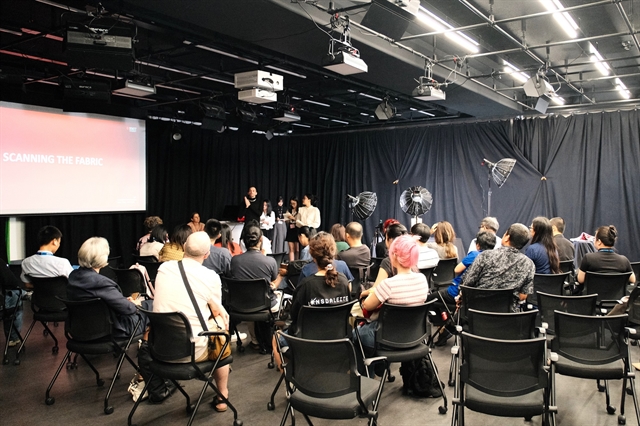 Society
Society
.jpg)
 |
| Representatives from local museums and archive centres and RMIT Vietnam staff experienced advanced 3D technology in preserving cultural heritage. Photo coutersy of RMIT Vietnam |
HÀ NỘI — Using 3D technology in cultural preservation and promoting indigenous heritage will give future generations access through digital mediums, ensuring cultural treasures continue to thrive and inspire.
That was the message of a short training section held for more than 35 participants from local museums and archive centres to get them thinking about the opportunities available.
The Việt Nam Design Research Studio for Sustainable and Resilient Fashion Futures (VDRS) project offered attendees a glimpse into the process of preserving historical and cultural heritage assets in the digital age.
3D technology is used widely by organisations globally, integrated into the fashion, design and digital media around the world, helping improve creative possibilities in these fields.
However, its use in preserving Việt Nam’s ethnic minorities’ traditional fashion and textiles is new and evolving.
The VDRS project, funded by RMIT Vietnam’s Strategic Innovation Challenge Fund, has adopted an innovative approach to take advantage of the technology in preserving the indigenous cultural heritage and foster a renewed appreciation of these traditions in a modern context.
Director of the National Archive Centre IV, Nguyễn Xuân Hùng said: “We face significant challenges in preserving and promoting nearly 34,000 woodblocks from the Nguyễn Dynasty.
"These large wooden artifacts boast intricate patterns, motifs and ancient Chinese characters in relief. Merely capturing them in photographs for an exhibition does not fully capture their impressive detail and craftsmanship.
“The 3D digitisation offered by the Adobe software ecosystem is an ideal solution for archiving these woodblocks. It enhances the visibility of the engravings and supports ideas for virtual exhibitions, allowing viewers to focus on key details. If effectively implemented, this technology could pave the way for future virtual exhibitions.”
The software was also useful for instantly converting artifacts, such as patterns from H’mong or Thai cultures, into 3D forms, according to An Thu Trà from the Museum of Ethnology.
"Its potential for enhancing the museum’s communication and education efforts, particularly in digitising traditional costumes and headscarves with unique ethnic designs," Trà sai.
Phương Thu Hiền from the Việt Nam Women Museum said in the digital era, museums need innovative approaches to present artifacts to the public, especially younger generations.
“In recent years, a growing number of young visitors have come to the museum, eager to learn about the history and traditions of Vietnamese women.
"We believe that integrating this new technology will make the museum’s artifacts more engaging and visually appealing, helping to connect them with the public, particularly younger audiences. Through this, we aim to inspire a deeper appreciation and understanding of the rich heritage of Vietnamese women,” Hiền said.
VDRS Project Manager, Corinna Joyce said the VDRS serves as a cornerstone in the preservation of traditional knowledge among 53 ethnic minorities in Việt Nam.
“We hope to build a platform that not only preserves this knowledge but also amplifies its voice," Joyce said.
"We are looking at the collaboration between diverse knowledge systems and artisans, hoping to not only preserve but also bring these textile traditions into a modern context, demonstrating how they can contribute to the evolution of the fashion industry."
The training strengthened new and existing partnerships between RMIT Vietnam and museums and archive centres across Việt Nam.
This supports RMIT’s ongoing efforts to merge traditional heritage with modern technological advancements, fostering a deeper understanding and appreciation of Việt Nam’s rich cultural tapestry. VNS
.jpg)



